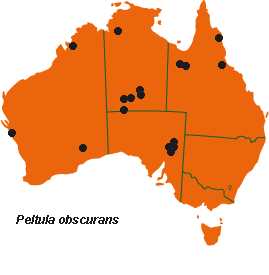



Australian Biological Resources Study
| Checklist of the Lichens of Australia and its Island Territories | ||
| Introduction | A–D | E–O | P–R | S–Z | Oceanic Islands | References | ||
| Peltula obscurans (Nyl.) Gyeln. | ||
| Repert. Spec. Nov. Regni Veg. 38: 308 (1935); Endocarpiscum obscurans Nyl., Bull. Soc. Linn. Normandie, sér. 2, 6: 309 (1872); Heppia obscurans (Nyl.) Nyl., in A.M.Hue, Rev. Bot. Bull. Mens. 5: 18 (1886); Heppia guepinii var. obscurans (Nyl.) Boistel, Nouv. Fl. Lich. 2: 87 (1903). T: Collioure, Pyrenees, France, 1872, W.Nylander; lecto: H-NYL 30900, fide C.M.Wetmore, Ann. Missouri Bot. Gard. 57: 187 ('1970') [1971]. Heppia acarosporoides Müll.Arg., Hedwigia 31: 194 (1892). T: Camp 1 & 2, W.A., 7 June 1891, R.Helms; holo: G. | ||
| Thallus squamulose; squamules orbicular, often rosette-shaped, sometimes deeply lobed, 0.5–2 mm diam., plane to convex, anchored by rhizines or an umbilicus; upper surface olive-brown to brown. Upper cortex absent; epinecral layer 11–13 µm thick, yellowish. Photobiont layer 45–120 µm thick. Medulla partly consisting of loosely interwoven hyphae and partly paraplectenchymatous with elongate cells 1–1.5 µm thick. Lower cortex indistinct to well developed, proso- to paraplectenchymatous, 15–26 µm thick; cells globose, to 6.5 µm diam. Apothecia 1 or 2 per squamule, immersed and finally filling the whole squamule, or adnate with a raised rim when mature and leaving the squamule margin as the rim; disc 0.3–1.2 mm diam., red to yellowish brown; epihymenium K– or K+ red to red-violet; hymenium wine-red or blue in iodine. Asci clavate to obclavate; ascus wall orange in iodine, blue after pretreatment with KOH. Ascospores more than 100 per ascus, oval to ellipsoidal, 4.6–8 × 2–4.6 µm. Pycnidia not known; conidia fusiform, 3.1–4.3 × 1.2–2.4 (–3.1) µm. |  |
|
| Occurs in W.A., N.T., S.A. and Qld; usually grows on calcareous and acidic rocks in deserts and other open arid habitats; rarely on soil. Also in southern and central U.S.A., Europe, southern and western Africa and Asia. | ||
| Büdel (2001) | ||
| Checklist Index |
| Introduction | A–D | E–O | P–R | S–Z | Oceanic Islands | References |
This work is copyright. Apart from any use as permitted under the Copyright Act 1968, no part may be reproduced by any process without prior written permission from Australian Biological Resources Study. Requests and inquiries concerning reproduction and rights should be addressed in the first instance to Dr P. McCarthy. These pages may not be displayed on, or downloaded to, any other server without the express permission of ABRS.